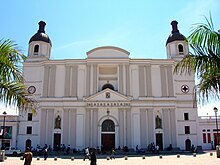
The predominant religion in Brazil is Christianity, with Catholicism being its largest denomination.
Religion in Africa is multifaceted and has been a major influence on art, culture and philosophy. Today, the continent's various populations and individuals are mostly adherents of Christianity, Islam, and to a lesser extent several traditional African religions. In Christian or Islamic communities, religious beliefs are also sometimes characterized with syncretism with the beliefs and practices of traditional religions.
Religion in Trinidad and Tobago, which is a multi-religious country, is classifiable as follows:

Islam is the majority religion in Azerbaijan, but the country is considered to be the most secular in the Muslim world. Estimates include 97.3% and 99.2% of the population identifying as Muslim. Of these, a majority belong to the Shia branch (55-65%), while a significant minority (35-45%) are Sunni. Traditionally, the differences between these two branches of Islam have not been sharply defined in Azerbaijan.

Christianity is the predominant religion in Mexico, with Catholicism being its largest denomination representing around 78% of the total population as of 2020. In recent decades the share of Catholics has been declining, due to the growth of other Christian denominations – especially various Protestant churches, Jehovah's Witness and Mormonism – which now constitute larger shares of the population. Conversion to non-Catholic denominations has been considerably lower than in Central America, and central Mexico remains one of the most Catholic areas in the world.

The Catholic Church in Haiti is part of the worldwide Catholic Church, under the spiritual leadership of the pope, the Curia in Rome and the Conference of Haitian Bishops.

Christianity is the most widely professed religion in the Dominican Republic. Historically, Catholicism dominated the religious practices of the country, and as the official religion of the state it receives financial support from the government. About 60% of Dominicans identify themselves as Catholic.
As of 2011, most Armenians in Armenia are Christians (97%) and are members of the Armenian Apostolic Church, which is one of the oldest Christian churches. It was founded in the 1st century AD, and in 301 AD became the first branch of Christianity to become a state religion.

Religion in Ethiopia consists of a number of faiths. Among these mainly Abrahamic religions, the most numerous is Christianity totaling at 67.3%, followed by Islam at 31.3%. There is also a longstanding but small Ethiopian Jewish community. Some adherents of the Baháʼí Faith likewise exist in a number of urban and rural areas. Additionally, there is also a substantial population of the adherents of traditional faiths.

The predominant religion in Kenya is Christianity, which is adhered to by an estimated 85.5% of the total population. Islam is the second largest religion in Kenya, practised by 10.9 percent of Kenyans. Other faiths practised in Kenya are Baháʼí, Buddhism, Hinduism and traditional religions.
Buddhism is the state religion of Cambodia. Approximately 97% of Cambodia's population follows Theravada Buddhism, with Islam, Christianity, and tribal animism as well as Baha’i faith making up the bulk of the small remainder. The wat and sangha (monkhood), together with essential Buddhist doctrines such as reincarnation and the accumulation of merit, are at the centre of religious life.

Christianity is the predominant religion in Georgia. The wide variety of peoples inhabiting Georgia has meant a correspondingly rich array of active religions in the country.

The most widely professed religion in Bosnia and Herzegovina is Islam and the second biggest religion is Christianity. Nearly all the Muslims of Bosnia are followers of the Sunni denomination of Islam; the majority of Sunnis follow the Hanafi legal school of thought (fiqh) and Maturidi theological school of thought (kalām). Bosniaks are generally associated with Islam, Croats of Bosnia and Herzegovina with the Roman Catholic Church, and Bosnian Serbs with the Serbian Orthodox Church. The State Constitution of Bosnia and Herzegovina (BiH) and the entity Constitutions of the Federation of Bosnia and Herzegovina and the Republika Srpska provide for freedom of religion, and the Government generally respects this right in ethnically integrated areas or in areas where government officials are of the majority religion; the state-level Law on Religious Freedom also provides comprehensive rights to religious communities. However, local authorities sometimes restricted the right to worship of adherents of religious groups in areas where such persons are in the minority.

Christianity is the most widely professed religion in Chile, with Catholicism being its largest denomination. The country is secular and the freedom of religion is established under its Constitution.

Christianity is the most widely professed religion in Zimbabwe, with Protestantism being its largest denomination.

Christianity is the predominant religion in Kiribati, with Catholicism being its largest denomination.

Haiti is a majority Christian country. Figures in 2020 suggest that 93% of the population belong to a Christian denomination.

The predominant religion in Honduras is Christianity, with Catholicism and Evangelicalism being its main denominations. The country is secular and the freedom of religion is enshrined in the nation's constitution.
The main religion in Morocco is Sunni Islam, which is also the state religion of the country. Officially, 99% of the population are Muslim, and virtually all of those are Sunni. The second-largest religion in the country is Christianity, but most Christians in Morocco are foreigners. There is a community of the Baháʼí Faith. Only a fraction of the former number of Maghrebi Jews have remained in the country, many having moved to Israel.

Mauritius is a religiously diverse nation, with Hinduism being the most widely professed faith. According to the 2011 census made by Statistics Mauritius, Hinduism is the major religion at 48.54%, followed by Christianity at 32.71%, followed by Islam 17.30% and Buddhism 0.18% in terms of number of adherents.

















